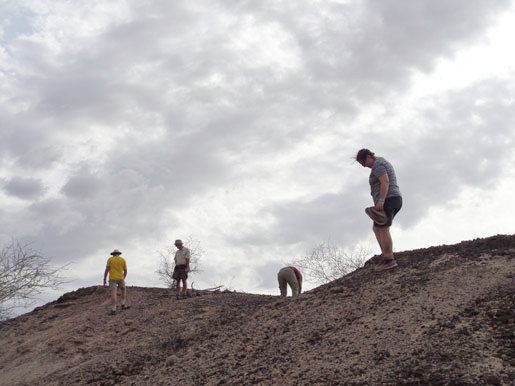I’ve been asked this question a lot recently because in June, I spent two weeks at Kanapoi, the famous site in northern Kenya. Kanapoi is where most fossils of the early human ancestor Australopithecus anamensis have been found. In the 1990s, work at the site was led by paleoanthropologist Dr. Meave Leakey, and today, Kanapoi is an important part of the West Turkana Paleo Project (WTPP). The project is led by Dr. Manthi of the National Museums of Kenya in collaboration with paleoanthropologists Carol Ward and Mike Plavcan. Also present this season were eminent geologist Craig Feibel, my advisor paleoecologist René Bobe, footprint specialists Brian Richmond and Kevin Hatala, the Kenyan staff and other graduate students.
I usually answer the question by first explaining that paleoanthropology is not always about digging. In my case it was mostly walking in the heat of the African desert for hours. As unbelievable as it sounds, doing just that is the regular day job of the local “fossil hunters.” I can’t describe how impressed I was by the dozen Kenyan guys who work at Kanapoi. Some are younger than I am and some are probably older than my grandfather but all of them have incredible skills. They can orient themselves when everything around looks the same and they can localize the smallest fossil amongst rocks all the while walking and teaching me Swahili!
Secondly, it’s not always about “cool” stuff. The “lame” stuff can turn out to be the most interesting finds after the data are analyzed. The reason I went to Kanapoi was to look at the fauna, because that is where my research interests lie. Every day for two weeks we pinpointed a specific area, went there and described every fossil we saw. And we’re not talking about bones with cutmarks or an elephant cemetery. Our list usually looked like this: “Fish bone, crocodile tooth, two fish bones…” and maybe a little mammal bone from time to time. At some localities there wasn’t even a single bone. But it is because of the data on the “lame” finds that we can infer the kinds of environments our ancestors lived in, what other species they may have interacted with, and what was available to eat. And to me, that’s extremely cool.
Also this trip was not only about keeping your eyes on the ground at all times. It was also about the people. All the wazungu (foreigners) in the team were given a Turkana name – mine was “Azurut,” which means mosquito. Central to the WTPP is giving back to the Turkana people who let us camp on their lands for a few weeks. I had the opportunity to sit in at an intercommunity meeting. We also visited a local school which receives important financial support from the project.
When a hominin bone is found at Kanapoi, the team usually sieves the surrounding area to make sure that not a single bone remains. I cannot reveal much about it, but on June 6th I found a very cool fossil in the sieve… So to be fair, the short answer is, “yes, I did find cool stuff digging in Africa!”
West Turkana Paleo Project (also on facebook!)


